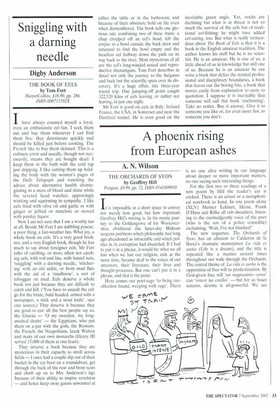Sniggling with a darning needle
Digby Anderson
THE BOOK OF EELS by Tom Fort HarperCollins, L16.99, pp. 286, ISBN 000711592X Ihave always counted myself a loyal, even an enthusiastic eel fan. I seek them out and buy them whenever I can find them live: they deteriorate quickly and should be killed just before cooking. The French like to buy them skinned. This is a culinary error and usually, though not necessarily, means they are bought dead. I keep them in the bath with the cold tap just dripping. I like cutting them up holding the body with the women's pages of the Daily Telegraph and watching the advice about alternative health disintegrating in a mess of blood and slime while the severed head watches, approvingly winking and squirming in sympathy. I like eels fried with olive oil and garlic or with ginger or jellied or matelote or stewed with parsley liquor.
Now I am not sure that I am a worthy fan at all. Beside Mr Fort I am dabbling poseur, a poor thing, a fair-weather fan, What joy, a whole book on eels. It's a very good book, too, and a very English book, though he has much to say about foreigner eels. Mr Fort talks of catching, or more often not catching eels, with rod and line, with funnel nets, `sniggling' with a darning needle, `stitchering' with an old sickle, or from mud flats with the aid of a `mudhorse', a sort of toboggan on mud. Eels deserve a whole book not just because they are difficult to catch and kill. ('You have to assault the eel: go for the brute, bald-headed, armed with a newspaper, a stick and a stout knife', says one source.) They deserve it because they are good to eat: all the best people say so, the Greeks — '0 my sweetest, my longawaited desire' — the Egyptians, who put them on a par with the gods, the Romans, the French, the Neapolitans, Izaak Walton and many of our own monarchs (Henry III served 15.000 of them at one feast).
They deserve a book because they are mysterious in their capacity to stroll across fields — I once had a couple slip out of their bucket in the car boot on a roundabout, get through the back of the rear and front seats and climb up on to Mrs Anderson's lap; because of their ability to inspire revulsion — and hence keep away guests unwanted at either the table or in the bathroom; and because of their obstinate hold on life even when dismembered. The book tells one glorious tale combining two of these traits: a chap chopped off an eel's head, left the corpse in a bowl outside the back door and returned to find the bowl empty and the headless eel halfway down the path on its way back to the river. Most mysterious of all are the eel's long-winded sexual and reproductive shenanigans. Tom Fort describes in detail not only the journey to the Sargasso and back but the scientific spats over its discovery. It's a huge affair, this three-year round trip. One jumping-off point caught 322,520 kilos of eels leaving, or rather not leaving, in just one night.
Mr Fort is good on eels in Italy. Ireland France, the USA, in Somerset and near the Dartford tunnel, He is even good on the inevitable green angle. Yes, stocks are declining but what is at threat is not so much the survival of the eels but of traditional eel-fishing; he might have added eel-eating, too. But what is really tremendous about The Book of Eels is that it is a book in the English amateur tradition. The author knows his stuff but he is no scientist. He is an amateur. He is one of us, a little ahead of us in knowledge but still one of us. Because he is an amateur he can write a book that defies the normal professional and disciplinary boundaries, a book that leaves out the boring bits, a book that moves easily from explanation to story to quotation. I suppose it is inevitable that someone will call this book 'enchanting'. Take no notice. Buy it anyway. Give it to someone you like or, for even more fun, to someone you don't.


























































 Previous page
Previous page